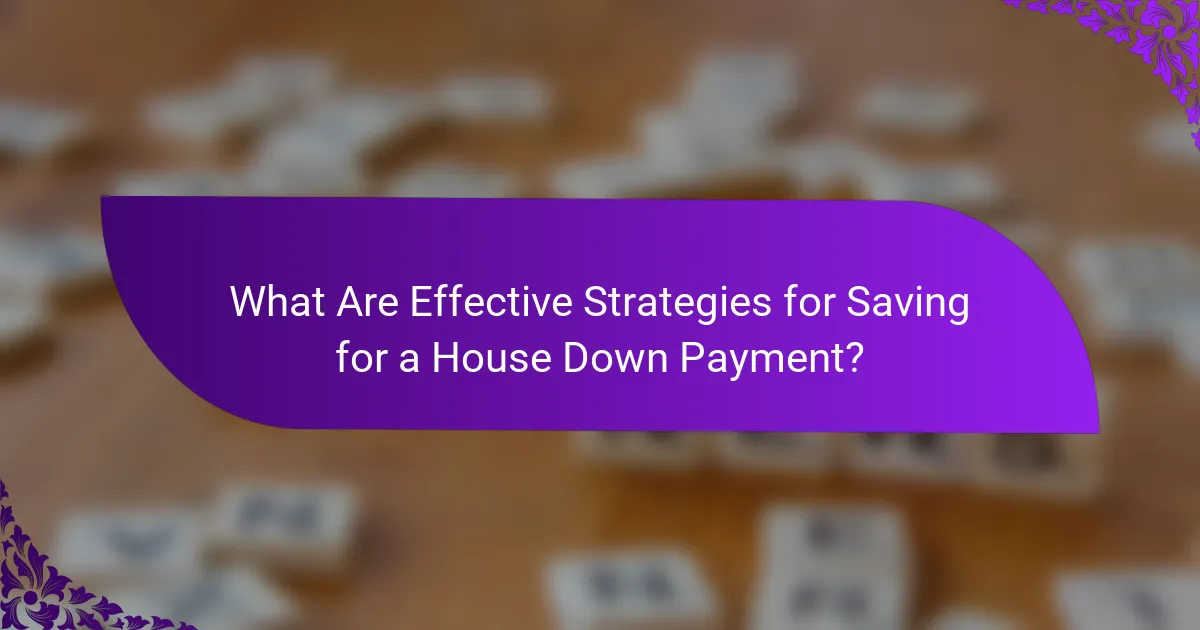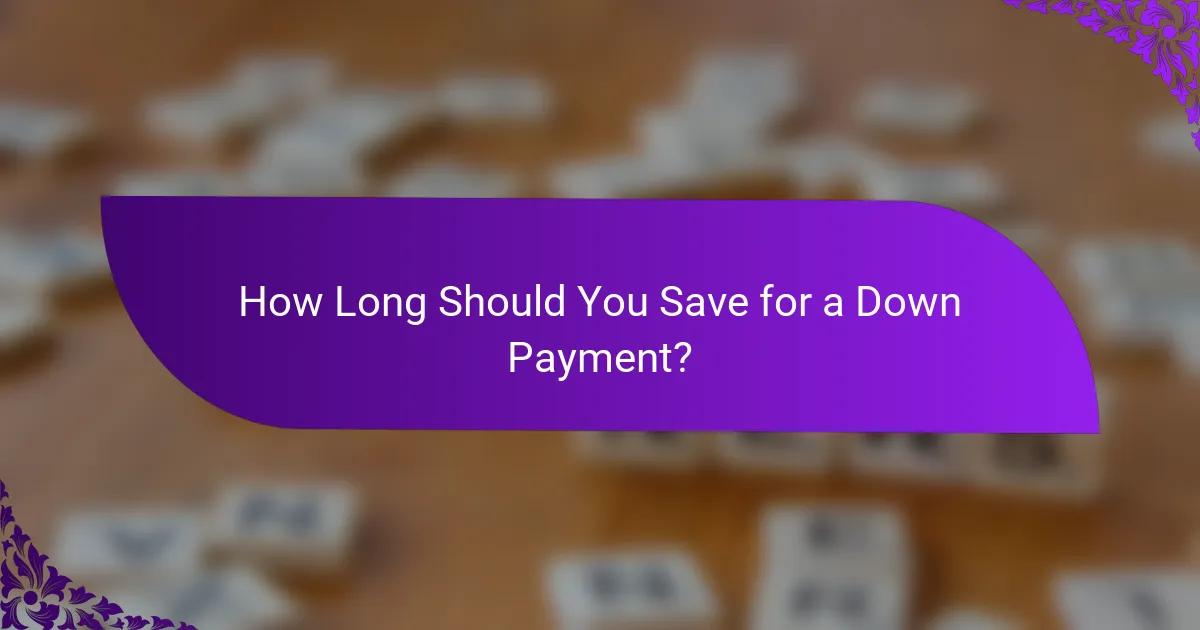Saving for a house down payment requires careful planning and effective budgeting strategies. By automating your savings and utilizing high-yield accounts, you can maximize your savings potential over time. Establishing a clear timeline, typically ranging from 3 to 5 years, allows you to set achievable goals and prepare for the journey to homeownership.

What Are Effective Strategies for Saving for a House Down Payment?
Effective strategies for saving for a house down payment include automating your savings, utilizing high-yield savings accounts, and creating a dedicated savings plan. These methods help streamline the process and maximize your savings potential over time.
Automating savings transfers
Automating savings transfers involves setting up your bank account to automatically transfer a specified amount of money into your savings account each month. This method ensures that you consistently save without having to think about it, making it easier to reach your down payment goal.
Consider starting with a small, manageable amount, such as 10-20% of your monthly income. As your financial situation improves, you can increase this amount to accelerate your savings.
Using high-yield savings accounts
High-yield savings accounts offer interest rates significantly higher than traditional savings accounts, allowing your money to grow faster. Look for accounts with no monthly fees and competitive interest rates to maximize your savings.
For example, if you deposit $10,000 in a high-yield savings account with an interest rate of 2%, you could earn around $200 in interest over a year, compared to minimal interest from a standard account.
Creating a dedicated savings plan
A dedicated savings plan outlines your savings goals, timelines, and strategies. Start by determining how much you need for a down payment, which typically ranges from 3% to 20% of the home’s purchase price, depending on the loan type.
Break down your goal into monthly savings targets. For instance, if you aim to save $20,000 in three years, you would need to save approximately $555 each month. Adjust your plan as needed to stay on track.
Cutting unnecessary expenses
Identifying and cutting unnecessary expenses can free up additional funds for your down payment savings. Review your monthly budget to find areas where you can reduce spending, such as dining out, subscriptions, or impulse purchases.
Consider implementing the 50/30/20 rule: allocate 50% of your income to needs, 30% to wants, and 20% to savings. This approach helps prioritize your savings while still allowing for some discretionary spending.
Exploring down payment assistance programs
Down payment assistance programs can provide financial aid to help cover your down payment and closing costs. These programs are often offered by state or local governments and may include grants, loans, or tax credits.
Research the options available in your area, as eligibility requirements and assistance amounts can vary. Some programs may require you to meet certain income limits or complete homebuyer education courses.

How Long Should You Save for a Down Payment?
The duration for saving a down payment typically ranges from 3 to 5 years, depending on your financial situation and housing market conditions. Establishing a clear timeline helps you set achievable savings goals and prepare for homeownership.
Typical saving timeline of 3-5 years
Most prospective homebuyers aim to save for a down payment over a period of 3 to 5 years. This timeframe allows you to accumulate a substantial amount, often ranging from 5% to 20% of the home’s purchase price, which can significantly impact your mortgage terms and monthly payments.
For example, if you plan to buy a home costing $300,000, saving 20% would require $60,000. Saving over 5 years means you would need to set aside approximately $1,000 each month, not accounting for any interest or investment gains.
Factors affecting your timeline
Several factors can influence how long it takes to save for a down payment. Your income, current expenses, and the cost of housing in your desired area play crucial roles. Additionally, any existing debt can affect your ability to save consistently.
Market conditions, such as rising home prices, may also prompt you to save more quickly. Conversely, if you find a property that meets your needs at a lower price, you might adjust your timeline accordingly.
Setting realistic savings goals
To set realistic savings goals, start by determining your target down payment amount based on your desired home price. Break this total down into manageable monthly savings that fit within your budget.
Consider using a savings calculator to visualize your progress and adjust your contributions as needed. Aim to review your budget regularly to ensure you stay on track and make necessary adjustments if your financial situation changes.

What Budgeting Techniques Help with Down Payment Savings?
Effective budgeting techniques can significantly enhance your ability to save for a house down payment. By implementing structured methods, you can allocate your income wisely and track your expenses to reach your savings goals more efficiently.
50/30/20 budgeting rule
The 50/30/20 budgeting rule divides your after-tax income into three categories: 50% for needs, 30% for wants, and 20% for savings and debt repayment. This method encourages you to prioritize essential expenses while still allowing for discretionary spending.
To apply this rule, calculate your monthly income and allocate accordingly. For example, if you earn $3,000 per month, aim to spend $1,500 on needs, $900 on wants, and set aside $600 for savings, including your down payment. This structured approach can help you stay focused on your savings target.
Zero-based budgeting approach
Zero-based budgeting requires you to assign every dollar of your income a specific purpose, ensuring that your income minus expenses equals zero. This technique promotes conscious spending and helps identify areas where you can cut back to increase your savings.
To implement zero-based budgeting, list all your income sources and expenses. Adjust your budget until every dollar is accounted for, directing surplus funds toward your down payment savings. This method can be particularly effective if you have fluctuating income or irregular expenses.
Tracking expenses with apps like Mint
Using expense tracking apps like Mint can simplify the budgeting process by automatically categorizing your spending and providing insights into your financial habits. These tools can help you stay accountable and identify areas where you can save more for your down payment.
To maximize the benefits of these apps, regularly review your spending reports and set specific savings goals within the app. This way, you can monitor your progress and make adjustments as needed, ensuring that you remain on track to achieve your down payment savings target.

What Are the Costs Associated with Buying a House?
Buying a house involves various costs beyond just the purchase price. Understanding these costs is crucial for effective budgeting and financial planning.
Down payment percentage requirements
The down payment is a percentage of the home’s purchase price that you pay upfront. Typically, this ranges from 3% to 20%, depending on the type of mortgage and lender requirements. For conventional loans, a 20% down payment can help you avoid private mortgage insurance (PMI), while FHA loans may allow as little as 3.5% down.
Consider your financial situation when deciding on the down payment amount. A larger down payment can reduce monthly payments and overall interest costs, but it may deplete your savings. Aim for a balance that allows you to maintain an emergency fund.
Closing costs and fees
Closing costs are additional expenses incurred when finalizing a home purchase, typically ranging from 2% to 5% of the loan amount. These costs can include appraisal fees, title insurance, and attorney fees. It’s essential to budget for these expenses in addition to your down payment.
Some lenders offer to cover part of the closing costs in exchange for a higher interest rate. Evaluate this trade-off carefully, as it can affect your long-term financial commitment. Always request a detailed estimate of closing costs early in the process to avoid surprises.
Ongoing homeownership expenses
Once you own a home, ongoing expenses will include property taxes, homeowners insurance, maintenance, and utilities. Property taxes can vary significantly based on location, so research local rates to factor them into your budget. Homeowners insurance is typically required by lenders and can cost several hundred to over a thousand dollars annually.
Regular maintenance is crucial to preserving your home’s value. Budgeting 1% to 2% of the home’s value annually for maintenance can help cover unexpected repairs. Additionally, consider setting aside funds for homeowners association (HOA) fees if applicable, which can add to your monthly expenses.

How Do Local Markets Impact Down Payment Savings?
Local housing markets significantly influence how much you need to save for a down payment. Factors such as property prices, demand, and regional economic conditions can affect both the amount required and the timeline for saving.
Regional housing market trends
Understanding regional housing market trends is essential for effective down payment savings. In areas with rapidly increasing property values, such as major cities, you may need to save a larger amount more quickly compared to regions with stable or declining prices.
For instance, in a booming market, home prices might rise by 5-10% annually, which means your savings goal must keep pace. Conversely, in a slower market, you might find opportunities to buy with a lower down payment or even negotiate better terms.
To navigate these trends, monitor local real estate reports and consider consulting with a real estate agent. They can provide insights into market forecasts and help you adjust your savings strategy accordingly.
